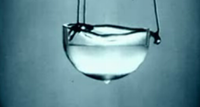
Photo from wikipedia
Josephson junctions are essential ingredients in the superconducting circuits used in many existing quantum technologies. Additionally, ultracold atomic quantum gases have also become essential platforms to study superfluidity. Here, we… Click to show full abstract
Josephson junctions are essential ingredients in the superconducting circuits used in many existing quantum technologies. Additionally, ultracold atomic quantum gases have also become essential platforms to study superfluidity. Here, we explore the analogy between superconductivity and superfluidity to present an intriguing effect caused by a thin finite barrier in a quasi-one-dimensional toroidal spinor Bose–Einstein condensate (BEC). In this system, the atomic current density flowing through the edges of the barrier oscillates, such as the electrical current through a Josephson junction in a superconductor, but in our case, there is no current circulation through the barrier. We also show how the nontrivial broken-symmetry states of spinor BECs change the structure of this Josephson-like current, creating the possibility to probe the spinor symmetry, solely using measurements of this superfluid current.
Journal Title: Symmetry
Year Published: 2022
Link to full text (if available)
Share on Social Media: Sign Up to like & get
recommendations!